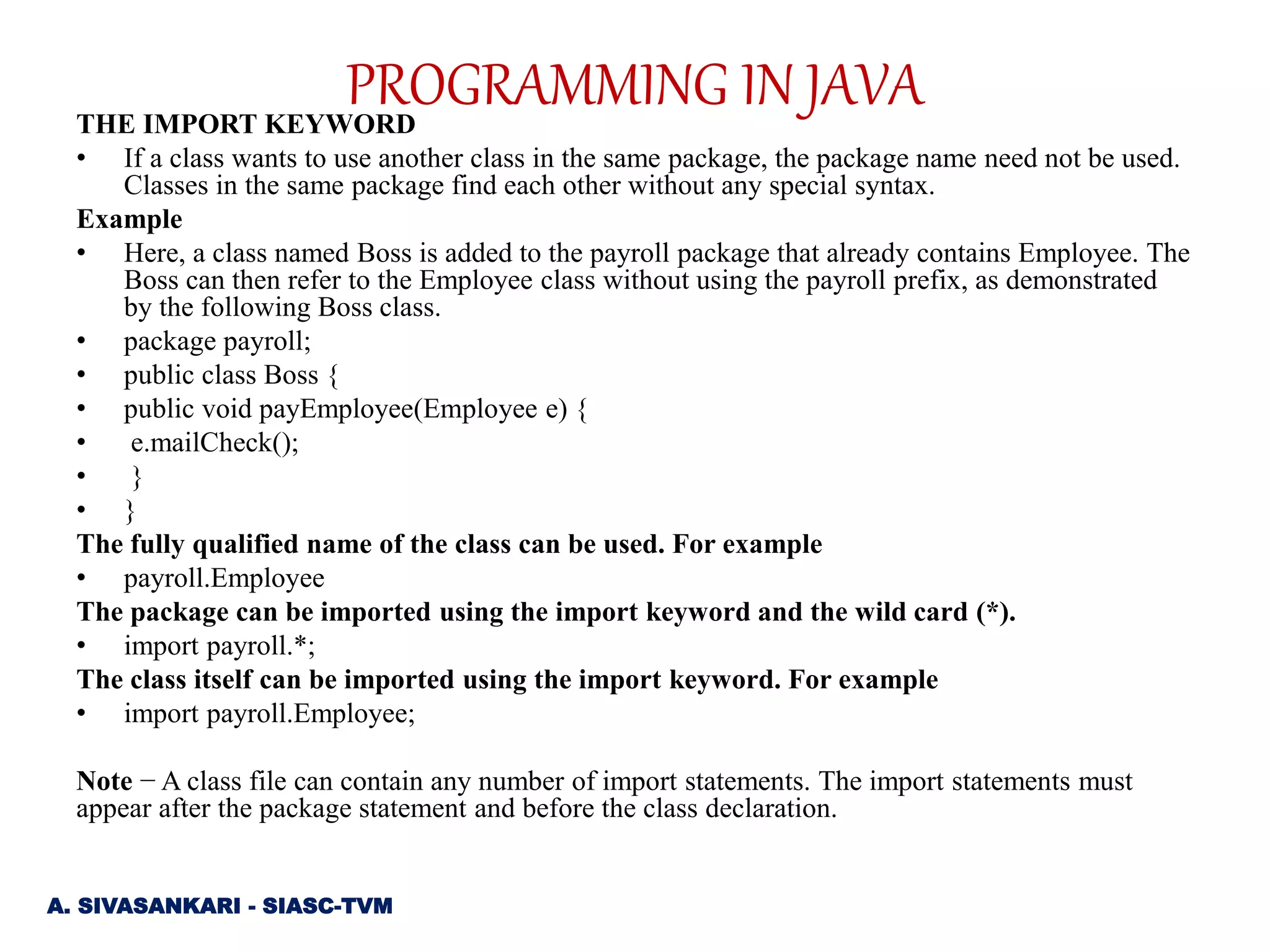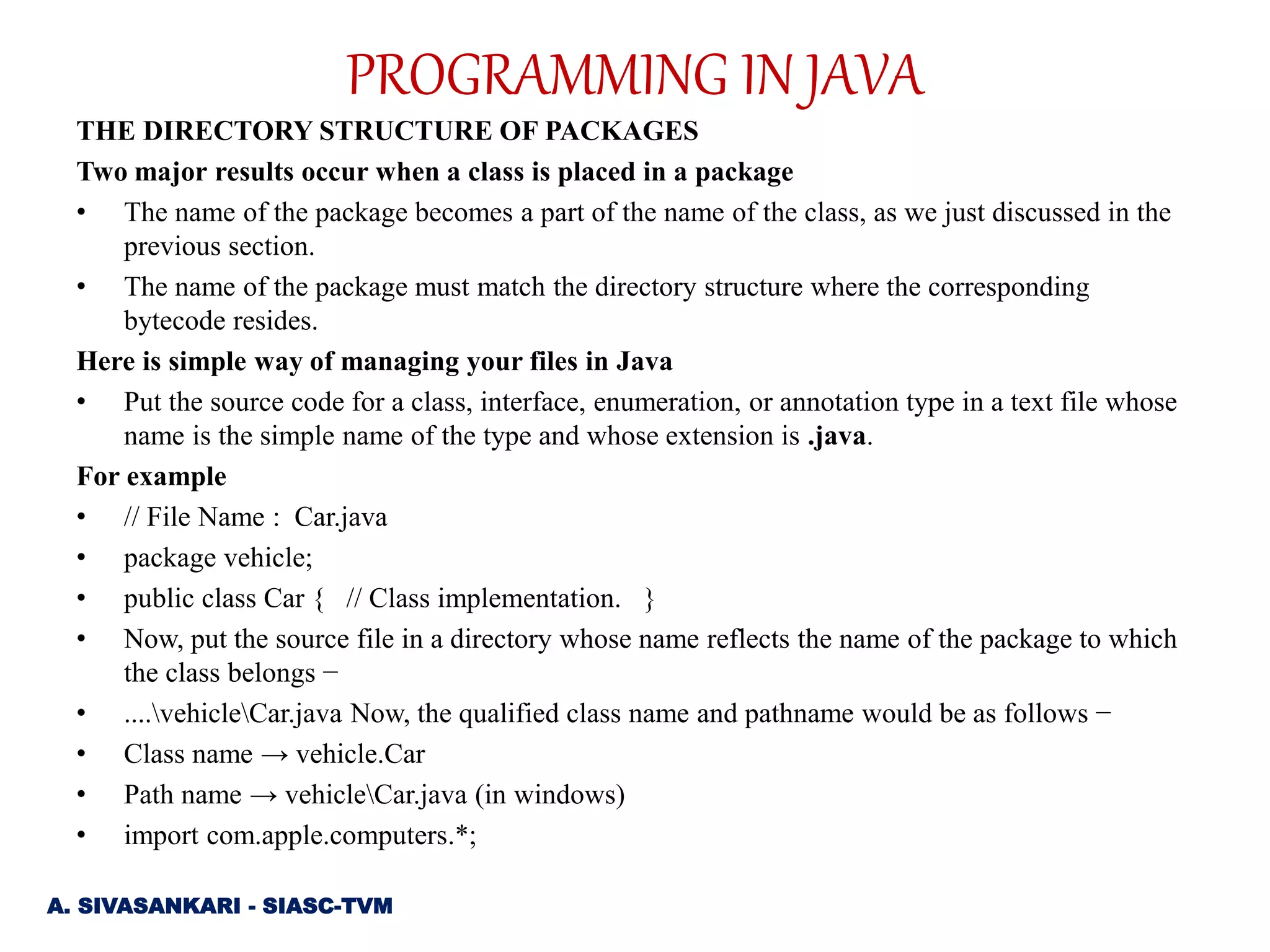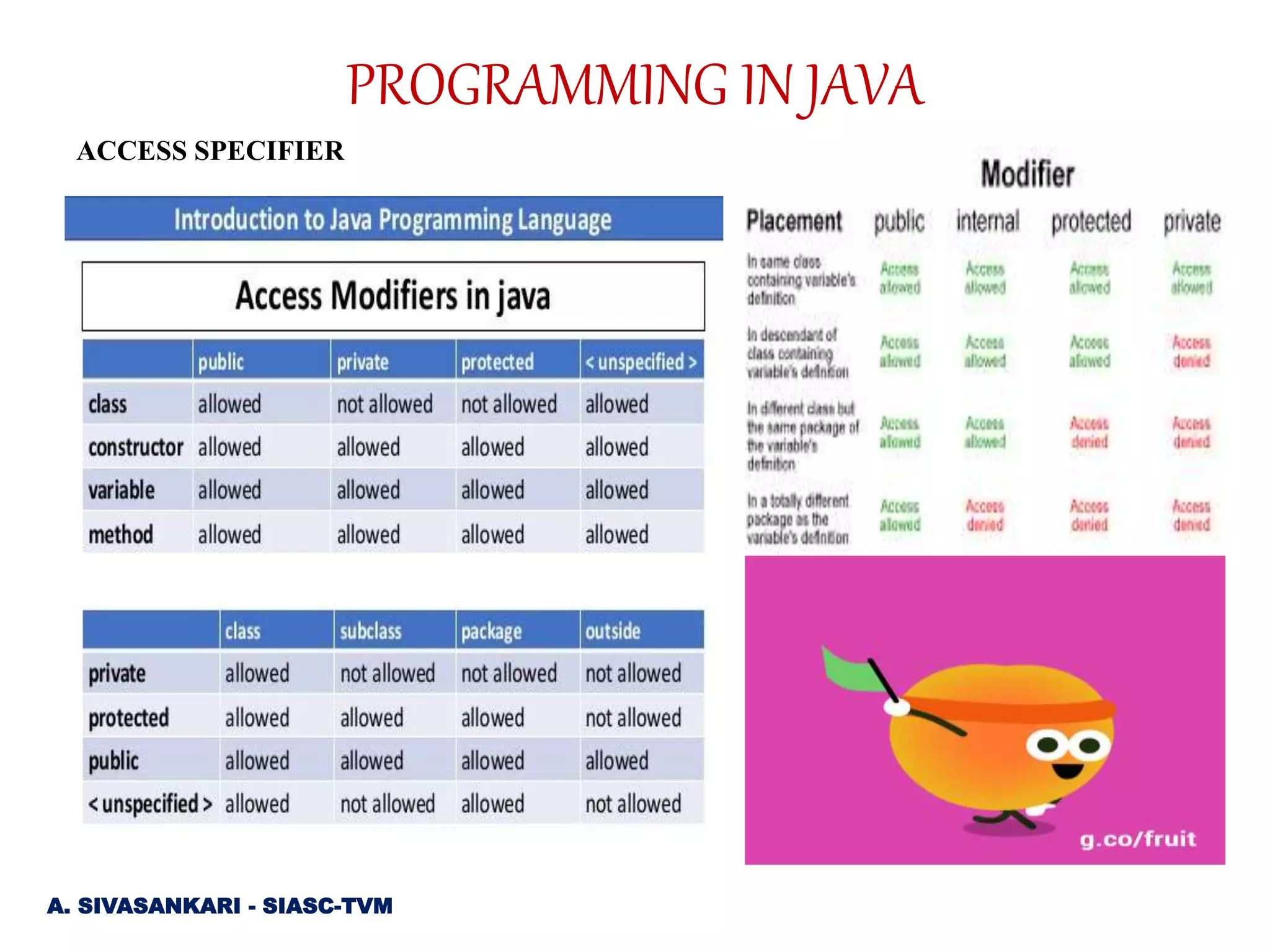This document discusses programming concepts in Java including arrays, inheritance, polymorphism, abstract classes, and interfaces. It provides examples and explanations of key concepts. The examples demonstrate declaring and using arrays, inheritance with the extends keyword, differentiating superclass and subclass members with the super keyword, abstract classes and methods, and implementing interfaces in classes. The document is intended to teach core object-oriented programming concepts in Java.
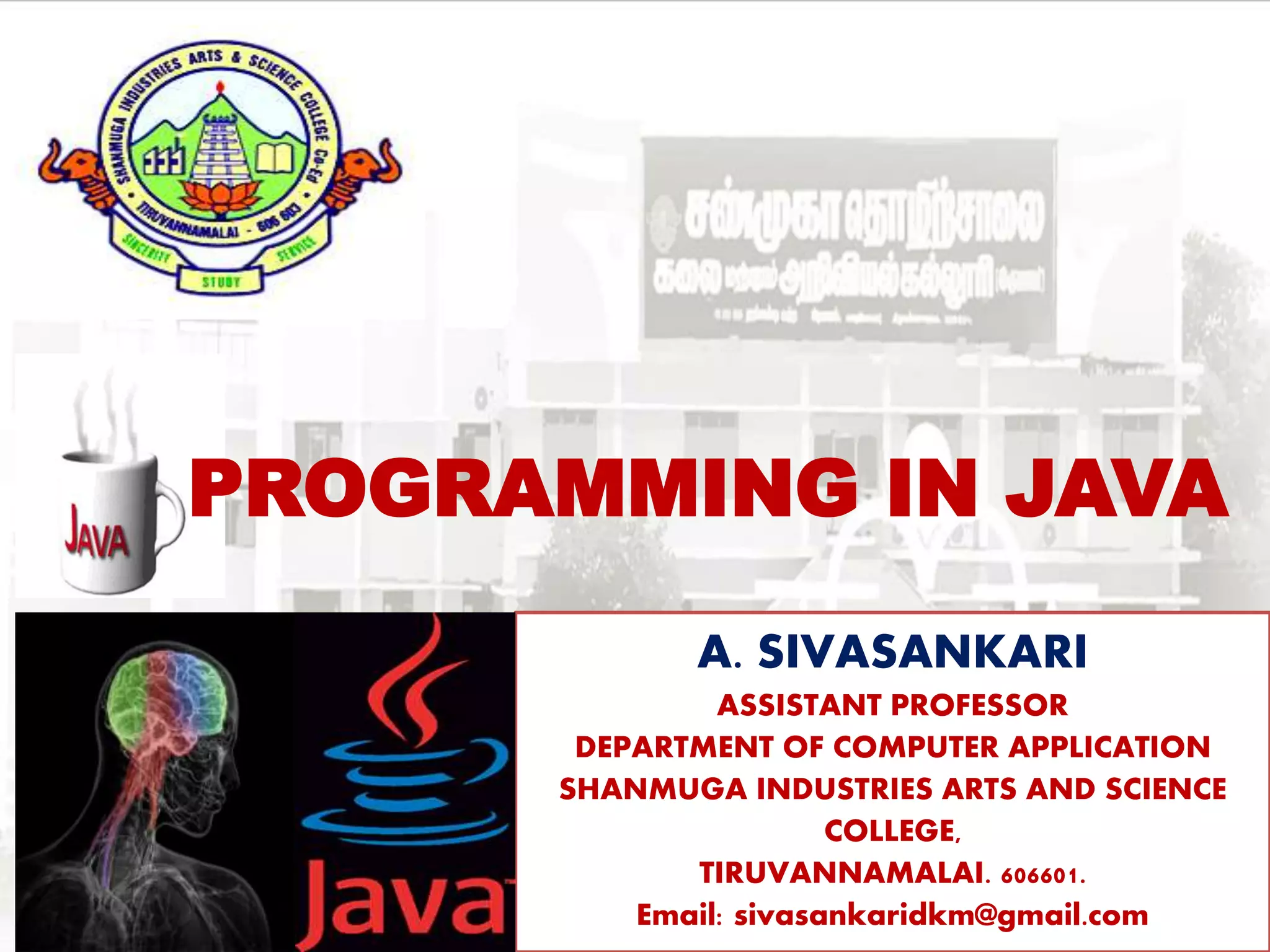
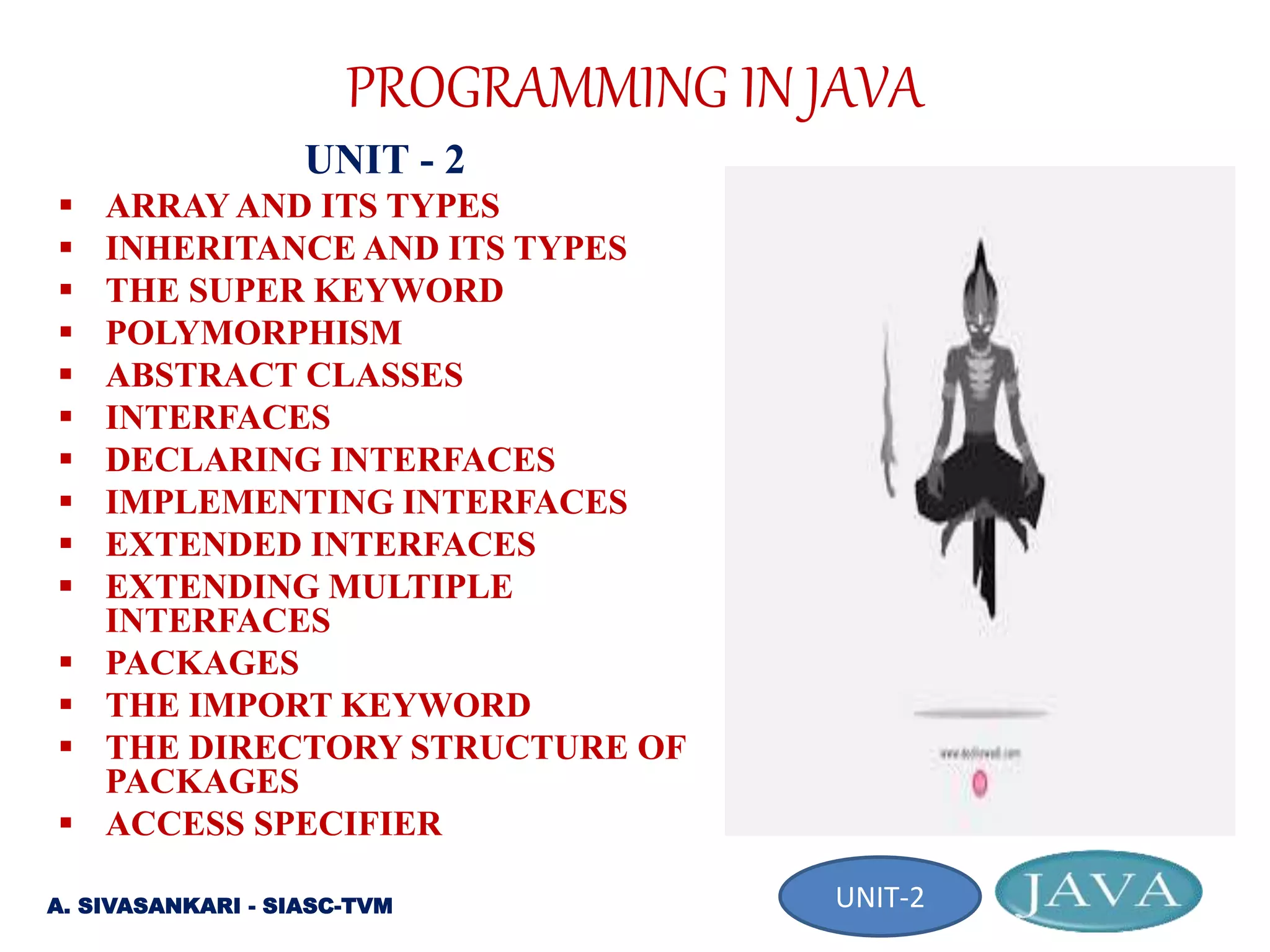
![ARRAY AND ITS TYPES • Group of elements and group of information is called array. TYPES • One dimensional Array • Two dimensional Array • Multi dimensional Array • Java provides a data structure, the array, which stores a fixed-size sequential collection of elements of the same type. An array is used to store a collection of data, but it is often more useful to think of an array as a collection of variables of the same type. • Instead of declaring individual variables, such as number0, number1, ..., and number99, you declare one array variable such as numbers and use numbers[0], numbers[1], and ..., numbers[99] to represent individual variables DECLARING ARRAY VARIABLES • To use an array in a program, We must declare a variable to reference the array, and you must specify the type of array the variable can reference • Syntax • dataType[] arrayRefVar; // preferred way. CREATING ARRAYS • We can create an array by using the new operator with the following syntax − Syntax • arrayRefVar = new dataType[arraySize]; A. SIVASANKARI - SIASC-TVM PROGRAMMING IN JAVA](https://image.slidesharecdn.com/java-unit2-200801165711/75/PROGRAMMING-IN-JAVA-3-2048.jpg)
![PROGRAMMING IN JAVA PROCESSING ARRAYS • When processing array elements, we often use either for loop or for each loop because all of the elements in an array are of the same type and the size of the array is known. • public static void main(String[] args) • { double[] myList = {1.9, 2.9, 3.4, 3.5}; // Print all the array elements • for (int i = 0; i < myList.length; i++) { • System.out.println(myList[i] + " "); • } // Summing all elements • double total = 0; • for (int i = 0; i < myList.length; i++) • { total += myList[i]; } • System.out.println("Total is " + total); // Finding the largest element • double max = myList[0]; • for (int i = 1; i < myList.length; i++) • { • if (myList[i] > max) max = myList[i]; • } System.out.println("Max is " + max); }} OUTPUT • 1.9 2.9 3.4 3.5 Total is 11.7Max is 3.5 A. SIVASANKARI - SIASC-TVM](https://image.slidesharecdn.com/java-unit2-200801165711/75/PROGRAMMING-IN-JAVA-4-2048.jpg)
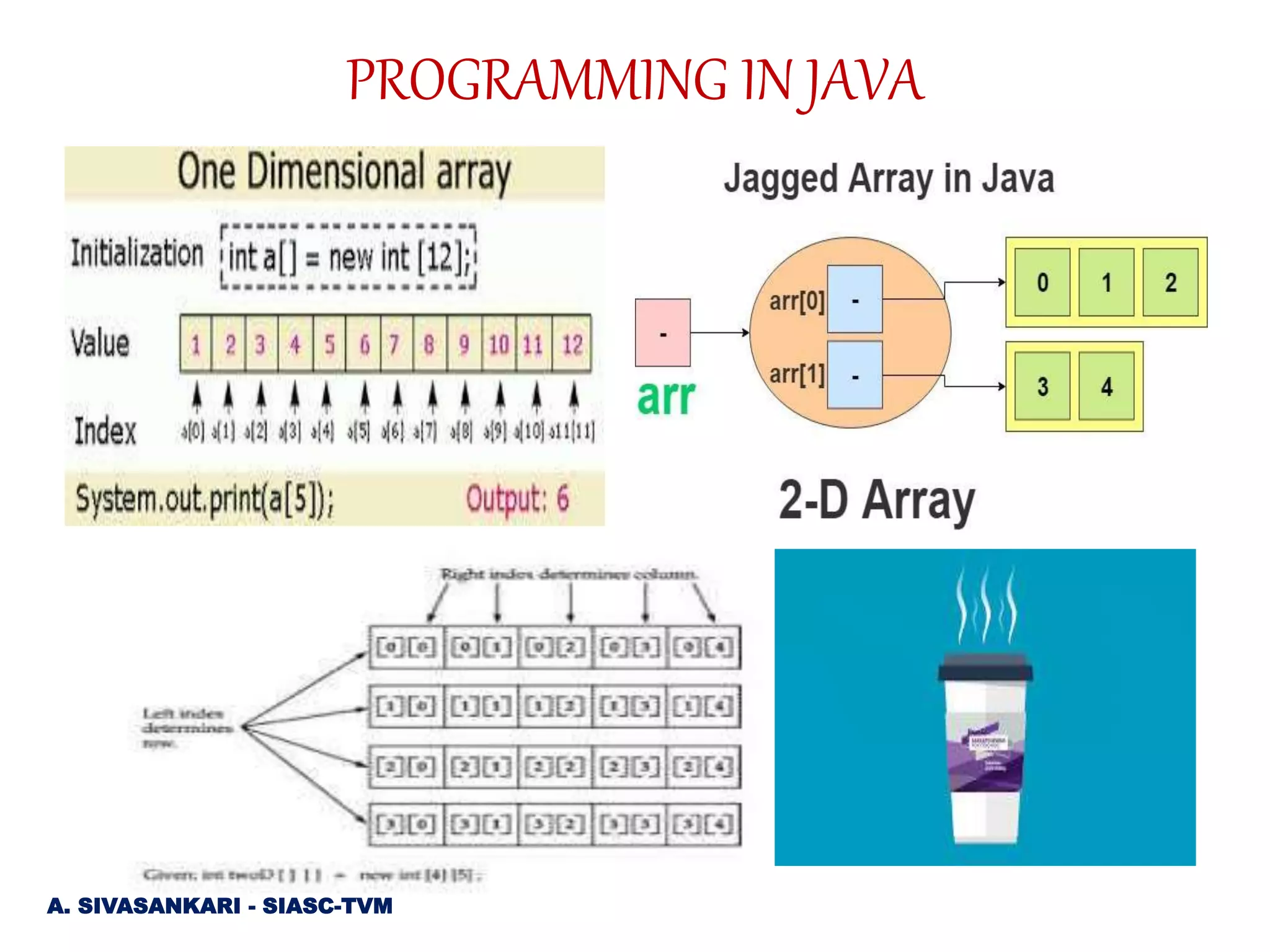
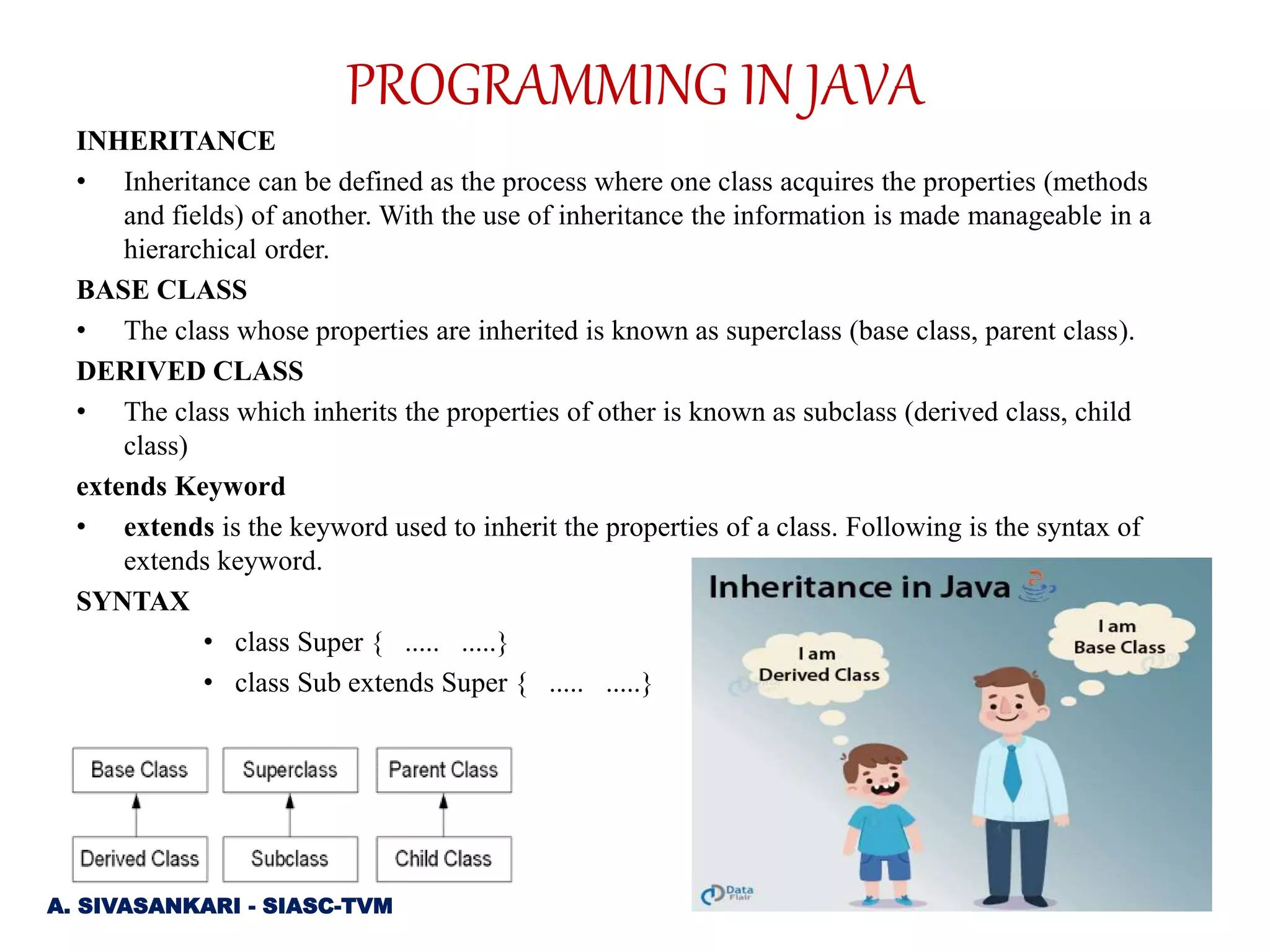
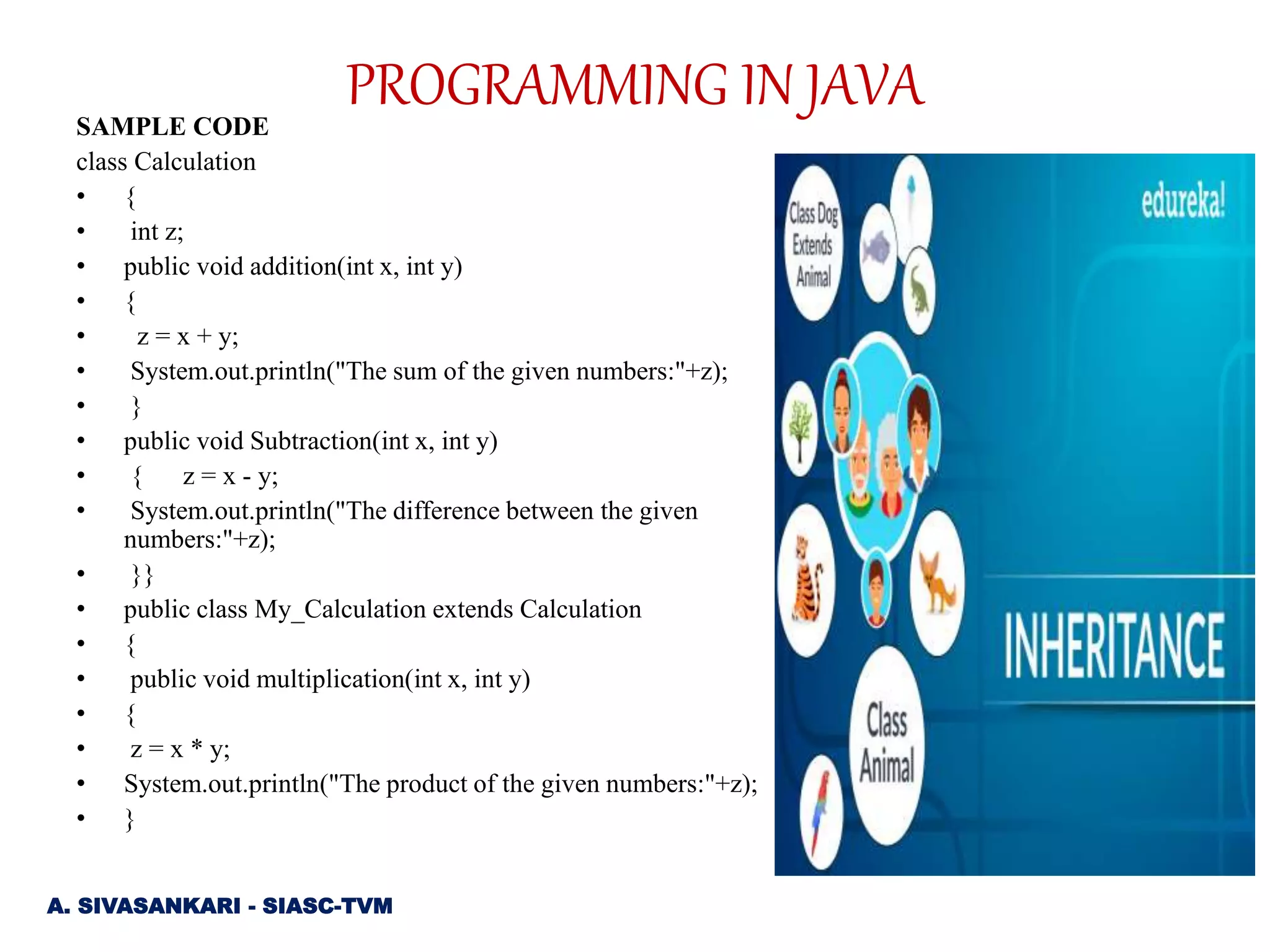
![public static void main(String args[]) • { • int a = 20, b = 10; • My_Calculation demo = new My_Calculation(); • demo.addition(a, b); • demo.Subtraction(a, b); • demo.multiplication(a, b); }} Compile and execute the above code as shown below. • javac My_Calculation.java • java My_Calculation After executing the program, it will produce the following result OUTPUT • The sum of the given numbers:30 • The difference between the given numbers:10 • The product of the given numbers:200 • Note − A subclass inherits all the members (fields, methods, and nested classes) from its superclass. Constructors are not members, so they are not inherited by subclasses, but the constructor of the superclass can be invoked from the subclass. A. SIVASANKARI - SIASC-TVM PROGRAMMING IN JAVA](https://image.slidesharecdn.com/java-unit2-200801165711/75/PROGRAMMING-IN-JAVA-8-2048.jpg)
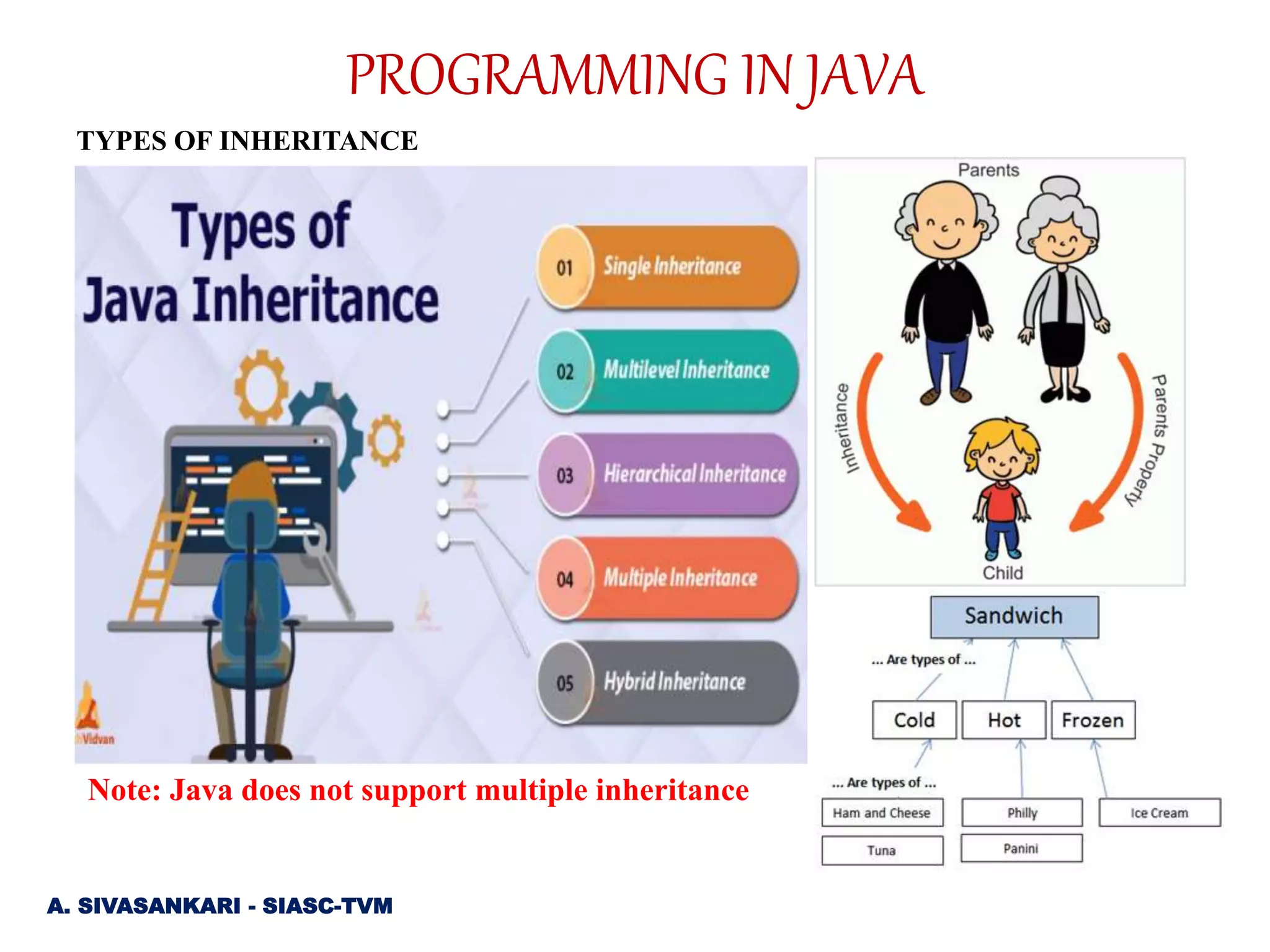
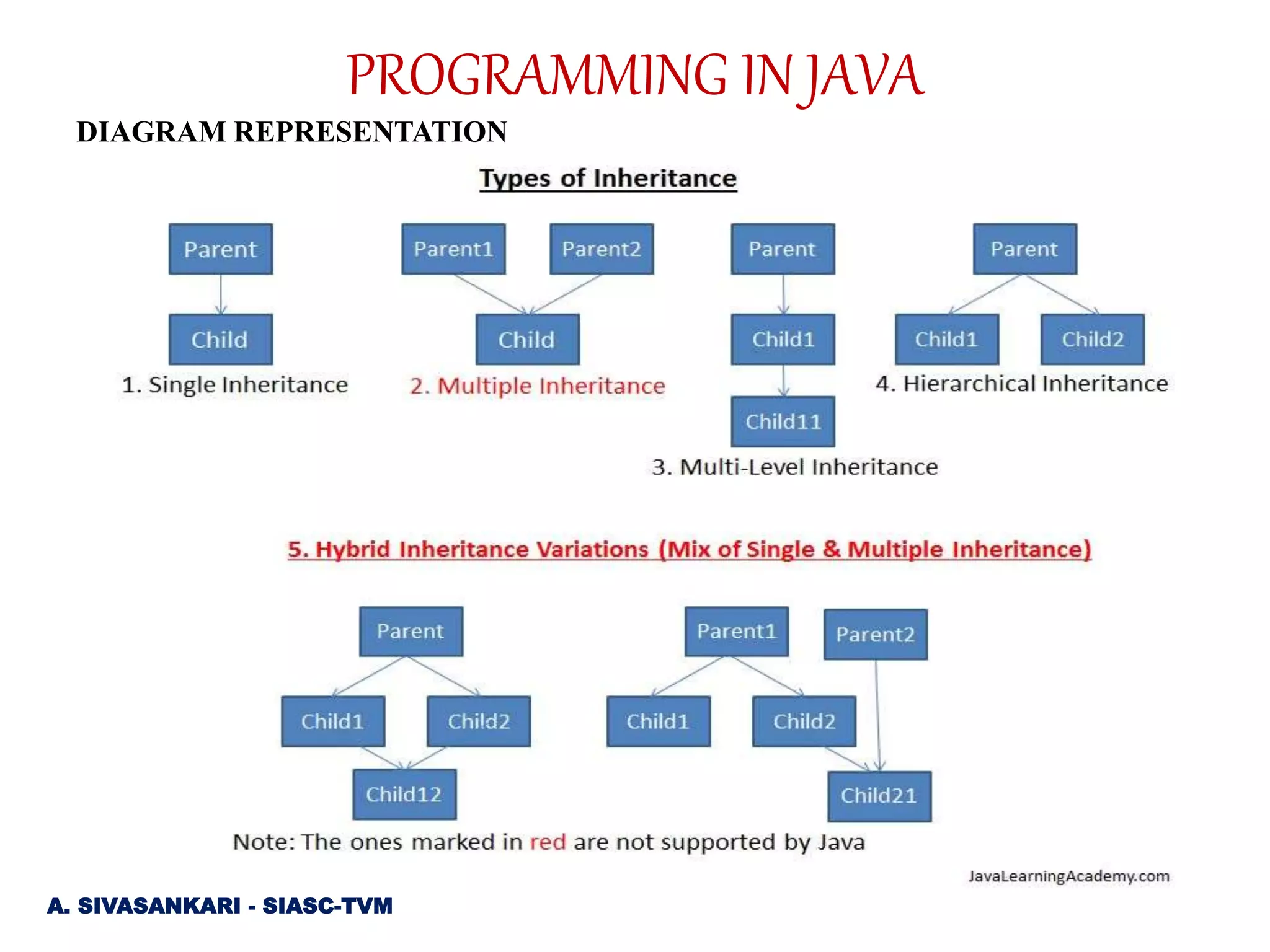
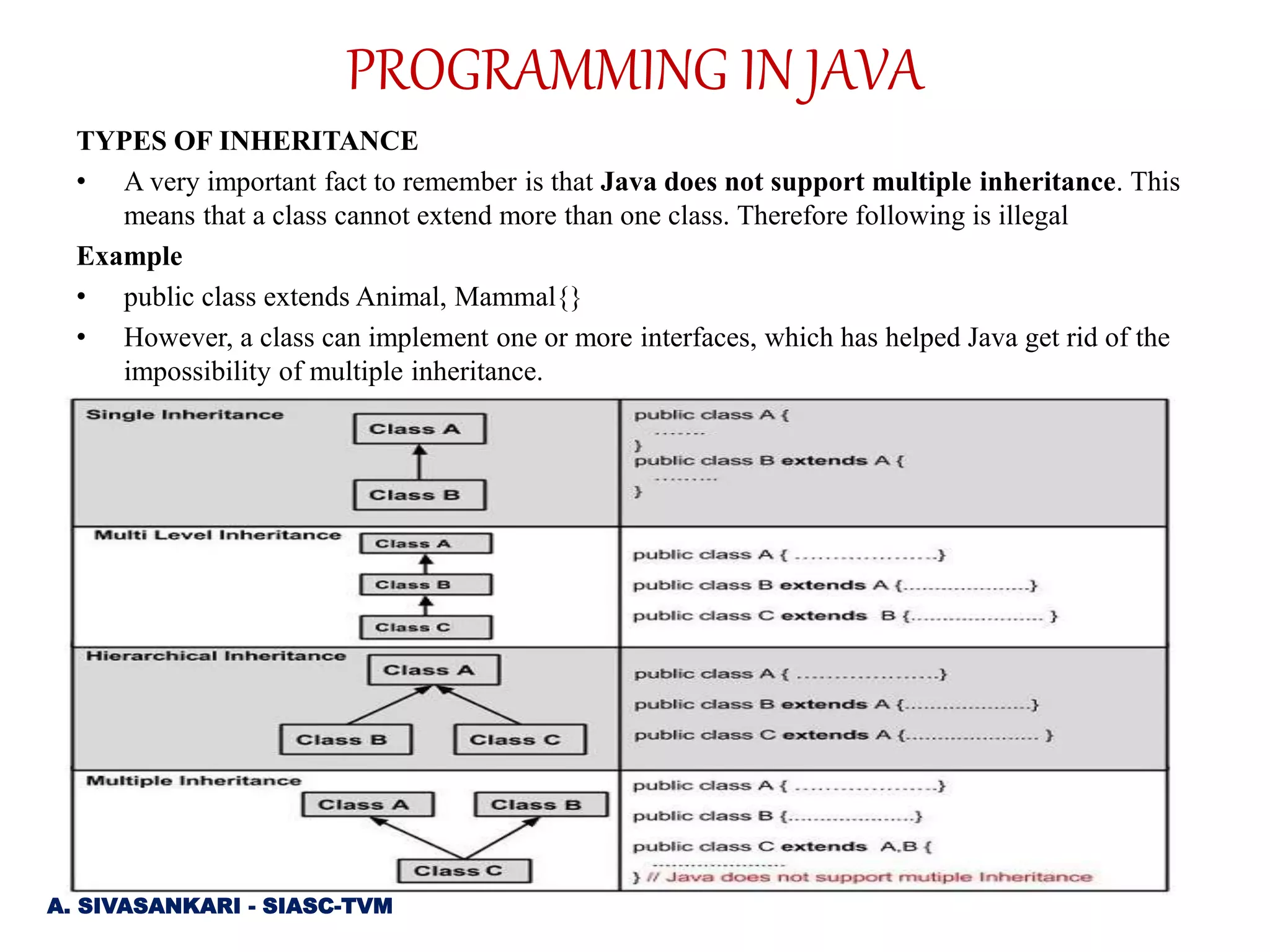
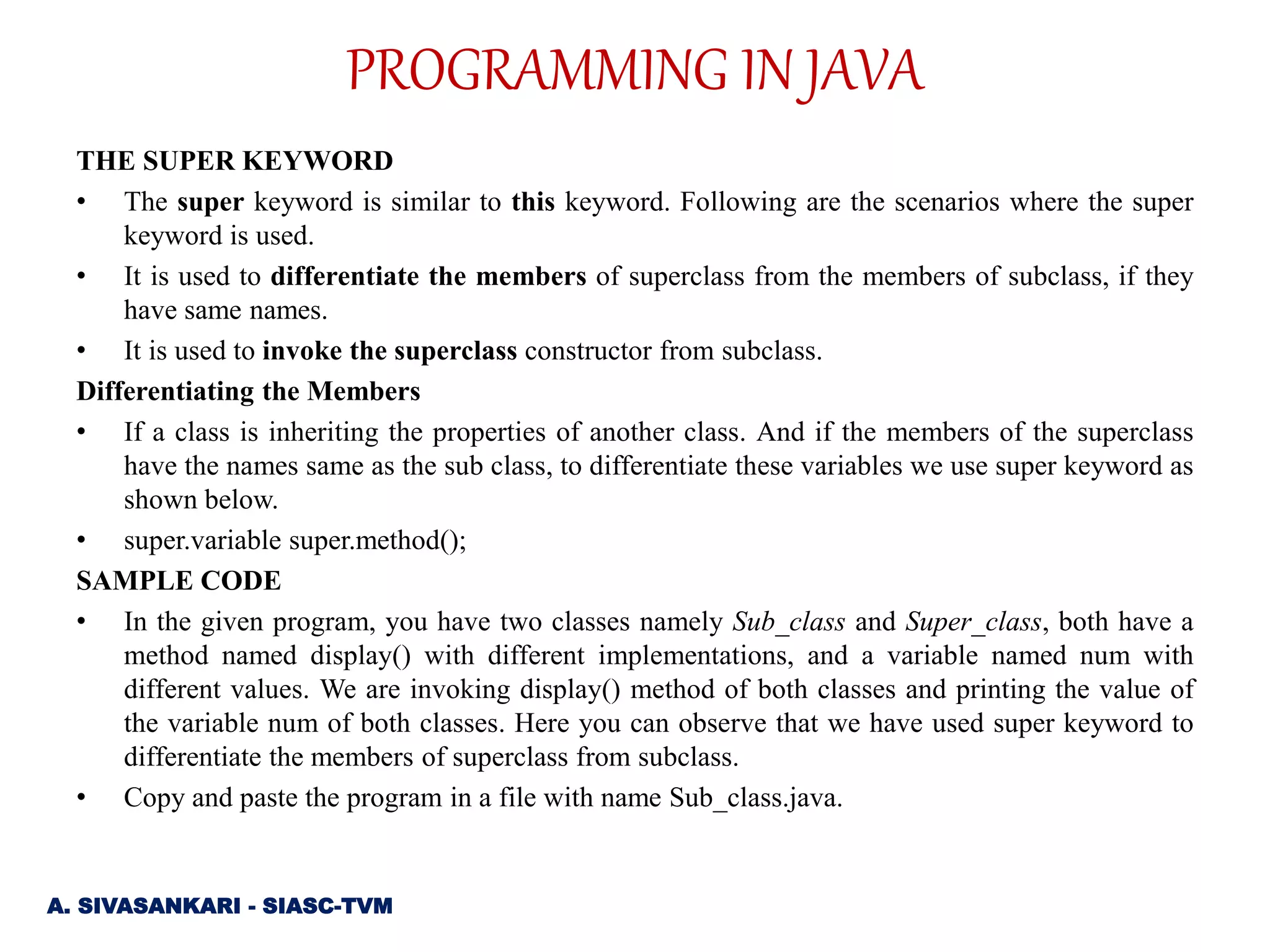
![• class Super_class • { int num = 20; // display method of superclass • public void display() { • System.out.println("This is the display method of superclass"); }} • public class Sub_class extends Super_class { • int num = 10; // display method of sub class public void display() { • System.out.println("This is the display method of subclass"); } • public void my_method() { // Instantiating subclass • Sub_class sub = new Sub_class(); // Invoking the display() method of sub class • sub.display(); // Invoking the display() method of superclass • super.display(); // printing the value of variable num of subclass • System.out.println("value of the variable named num in sub class:"+ sub.num); • // printing the value of variable num of superclass • System.out.println("value of the variable named num in super class:"+ super.num); } • public static void main(String args[]) { Sub_class obj = new Sub_class(); obj.my_method(); }} Compile and execute the above code using the following syntax. • javac Super_Demo • java Super OUTPUT • This is the display method of subclass • This is the display method of superclass • value of the variable named num in sub class:10 • value of the variable named num in super class:20 A. SIVASANKARI - SIASC-TVM PROGRAMMING IN JAVA](https://image.slidesharecdn.com/java-unit2-200801165711/75/PROGRAMMING-IN-JAVA-13-2048.jpg)
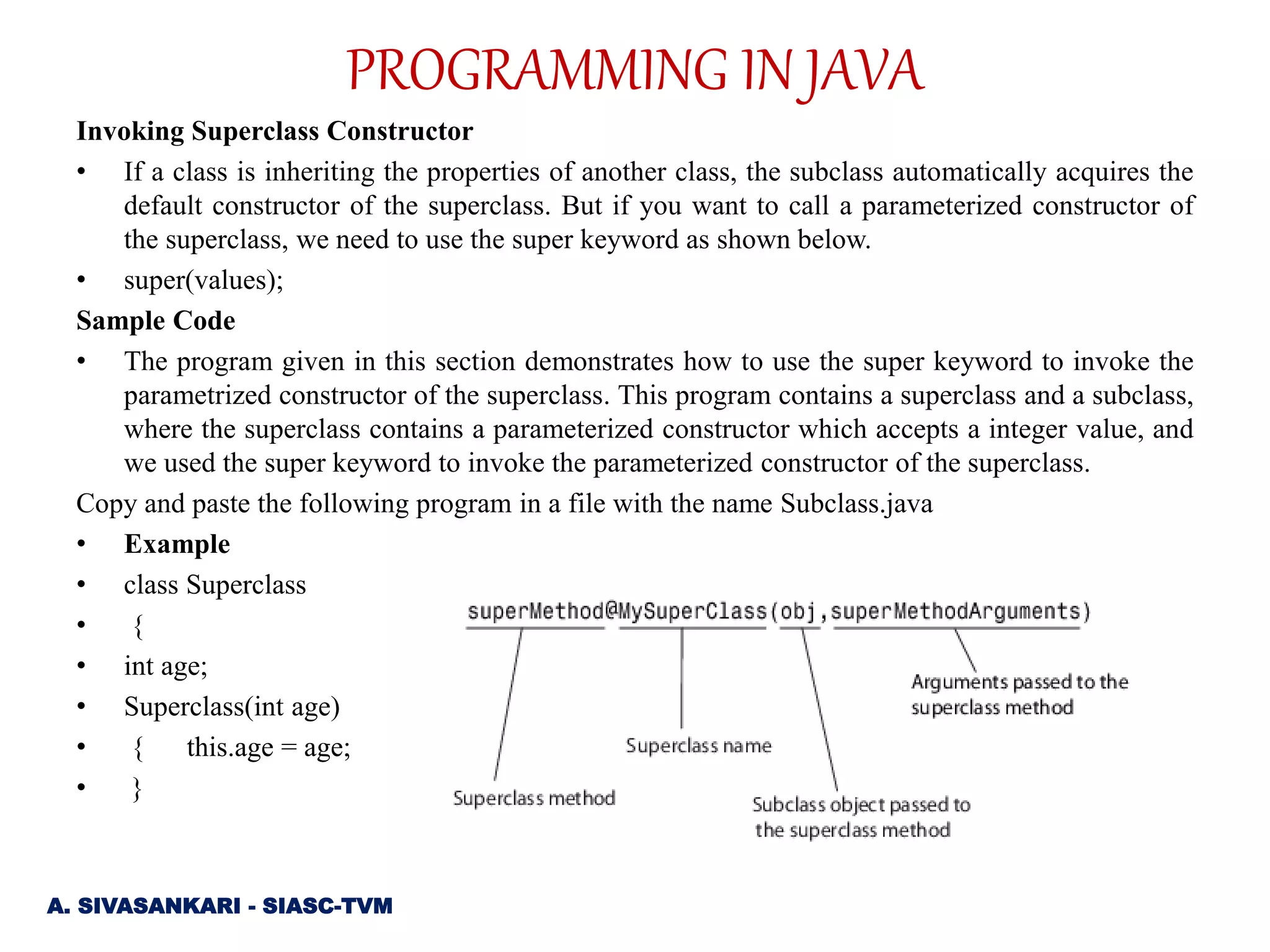
![• public void getAge() • { • System.out.println("The value of the variable named age in super class is: " +age); }} • public class Subclass extends Superclass { • Subclass(int age) { • super(age); • } • public static void main(String args[]) • { Subclass s = new Subclass(24); • s.getAge(); • }} Compile and execute the above code using the following syntax. • javac Subclass • java Subclass Output • The value of the variable named age in super class is: 24 A. SIVASANKARI - SIASC-TVM PROGRAMMING IN JAVA](https://image.slidesharecdn.com/java-unit2-200801165711/75/PROGRAMMING-IN-JAVA-15-2048.jpg)
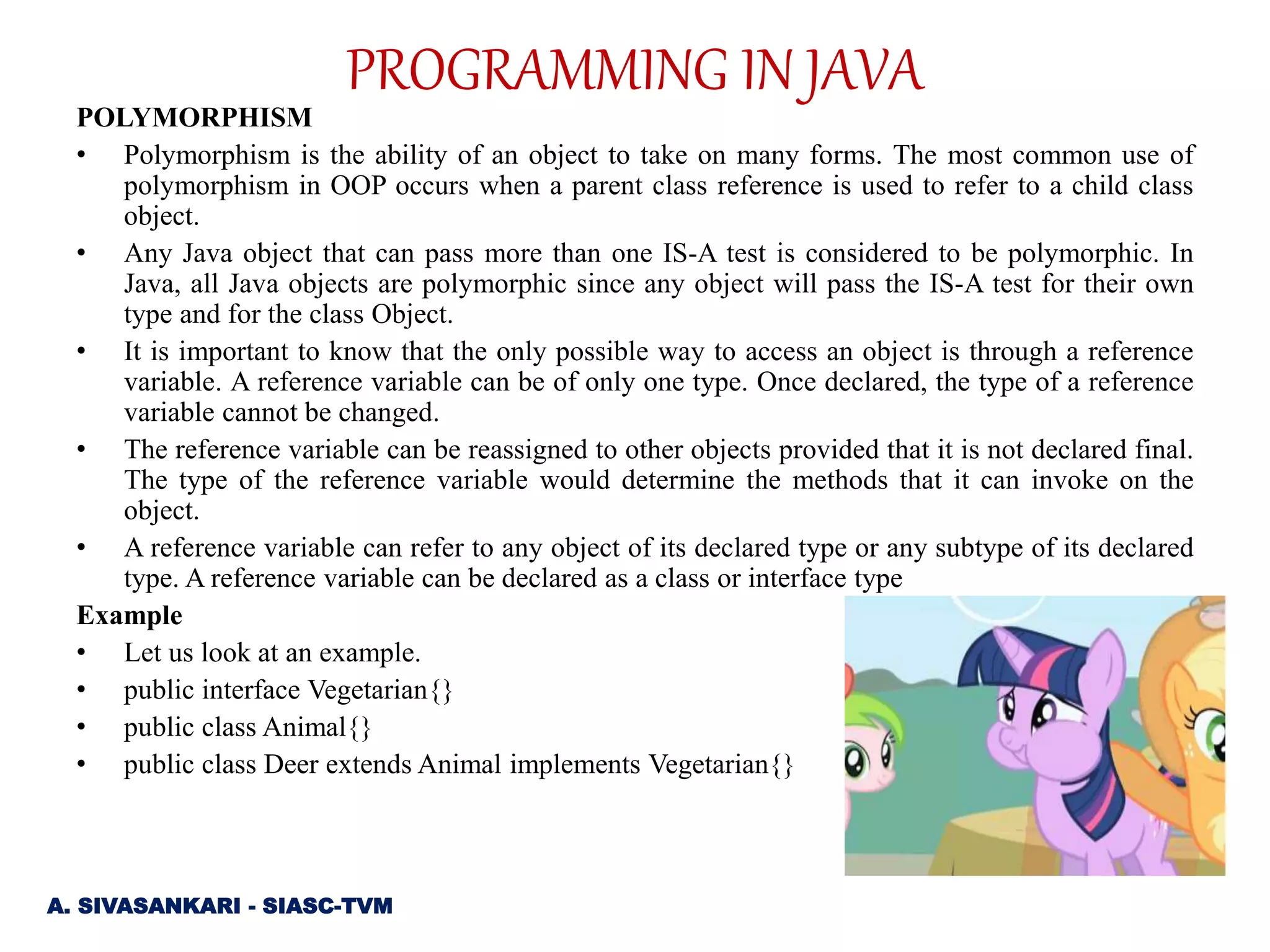
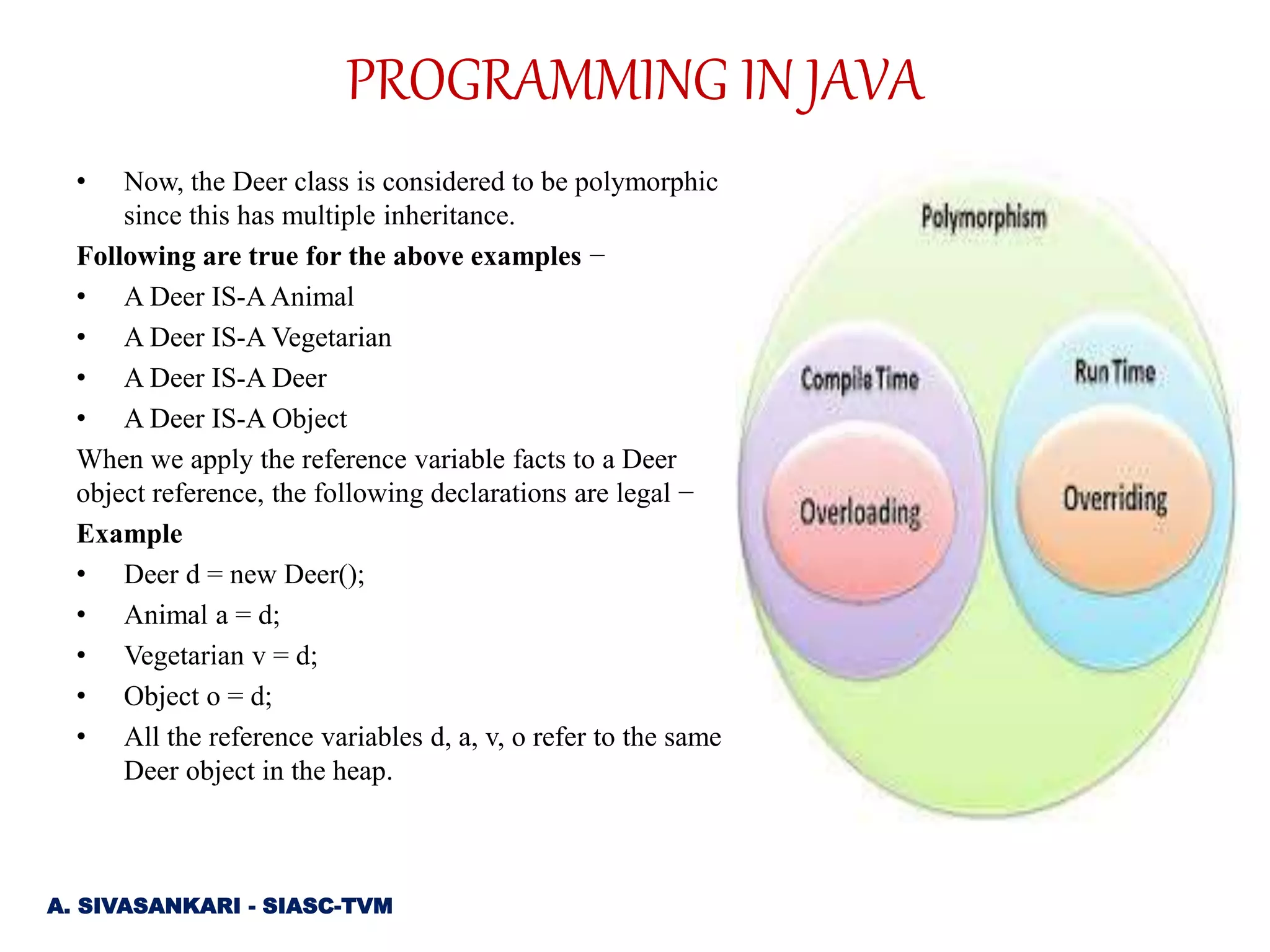
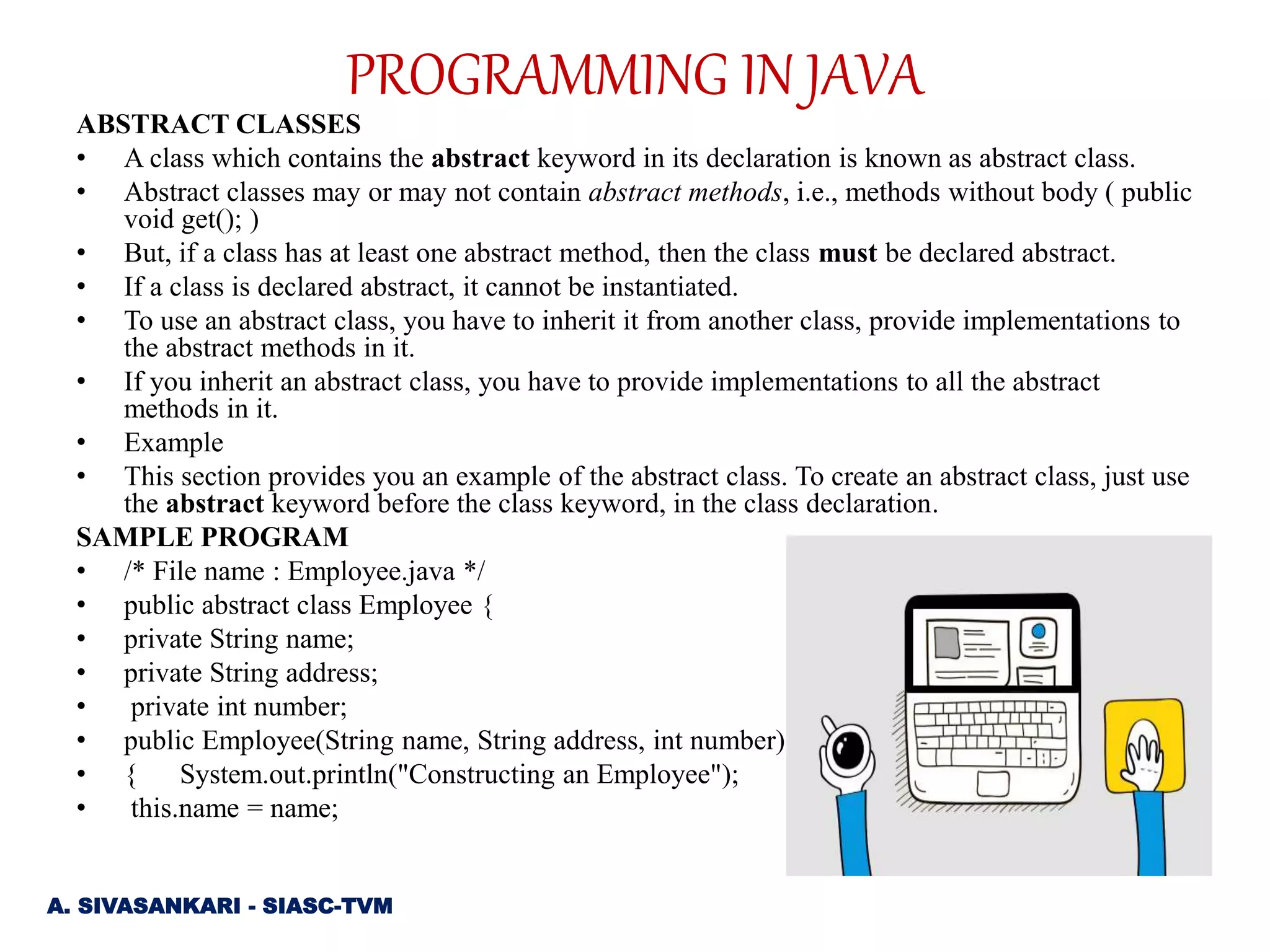
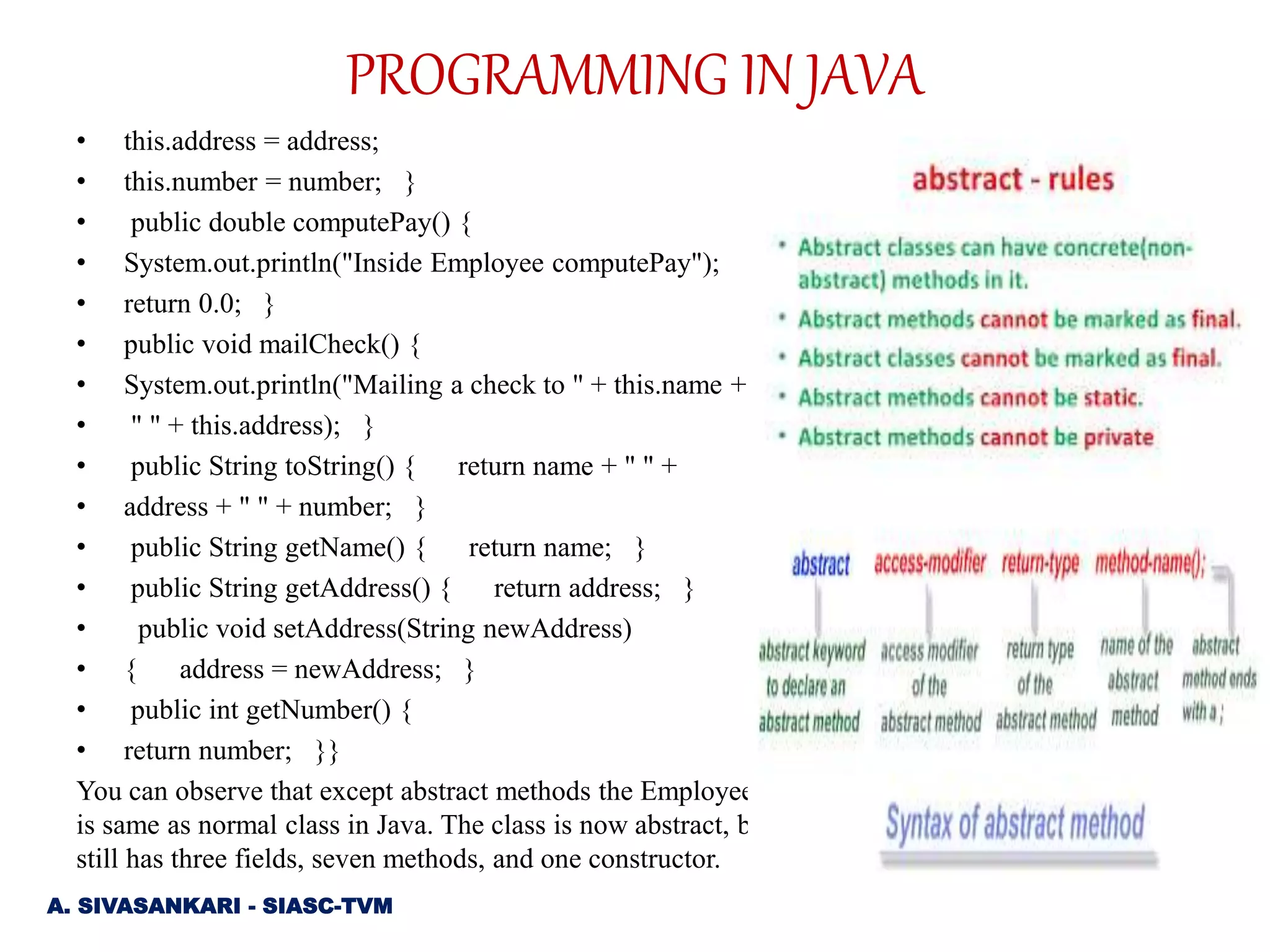
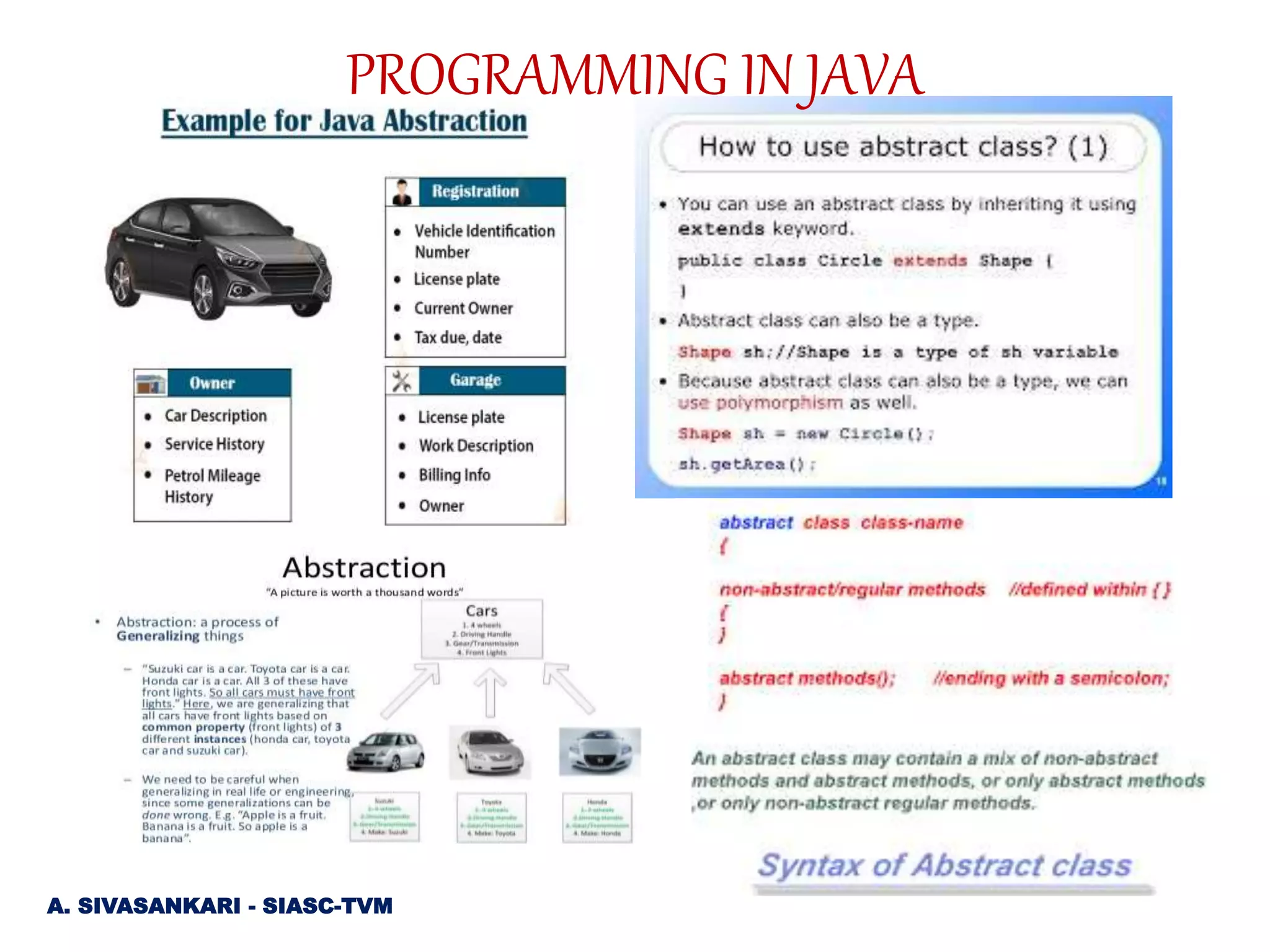
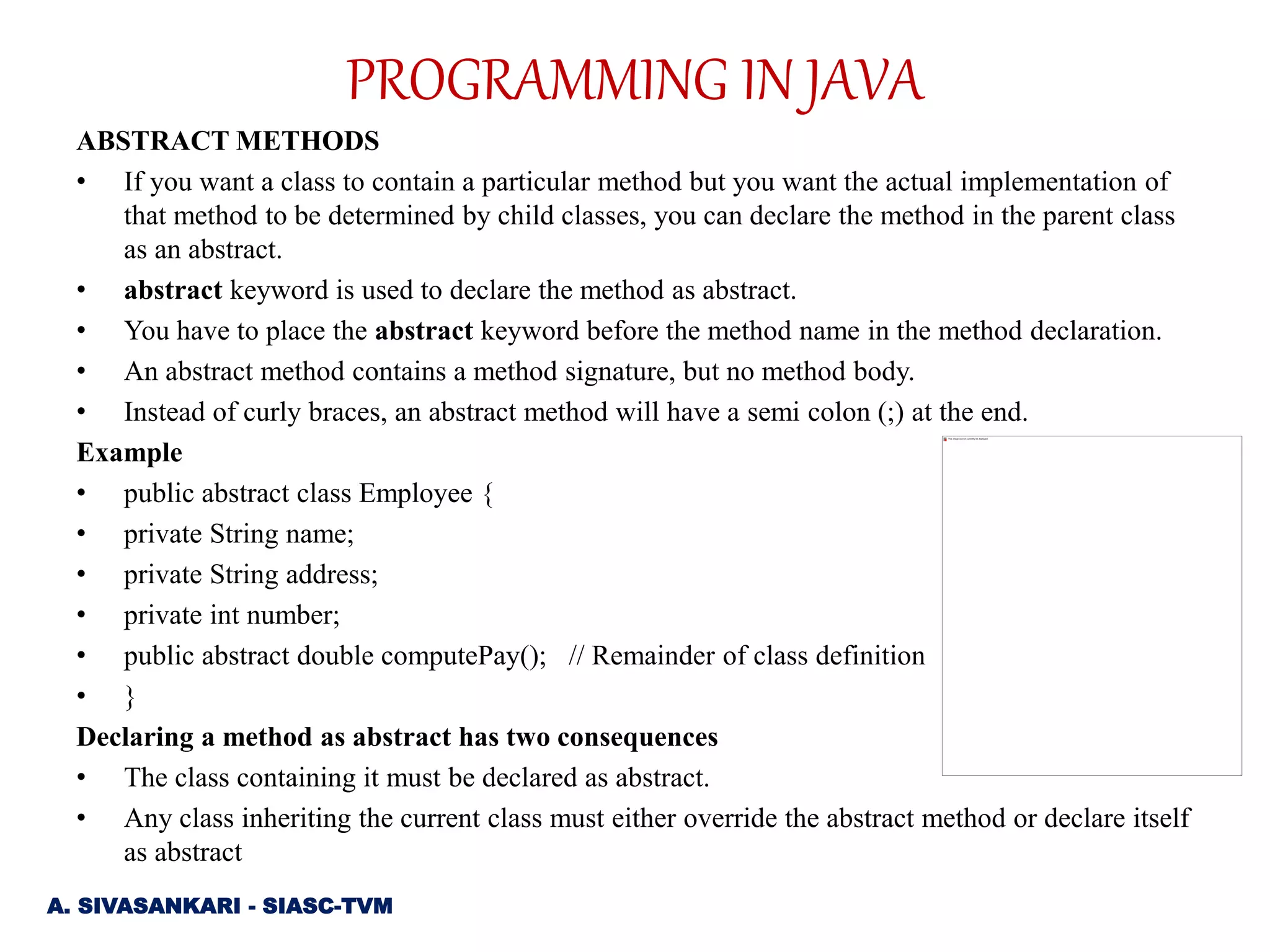
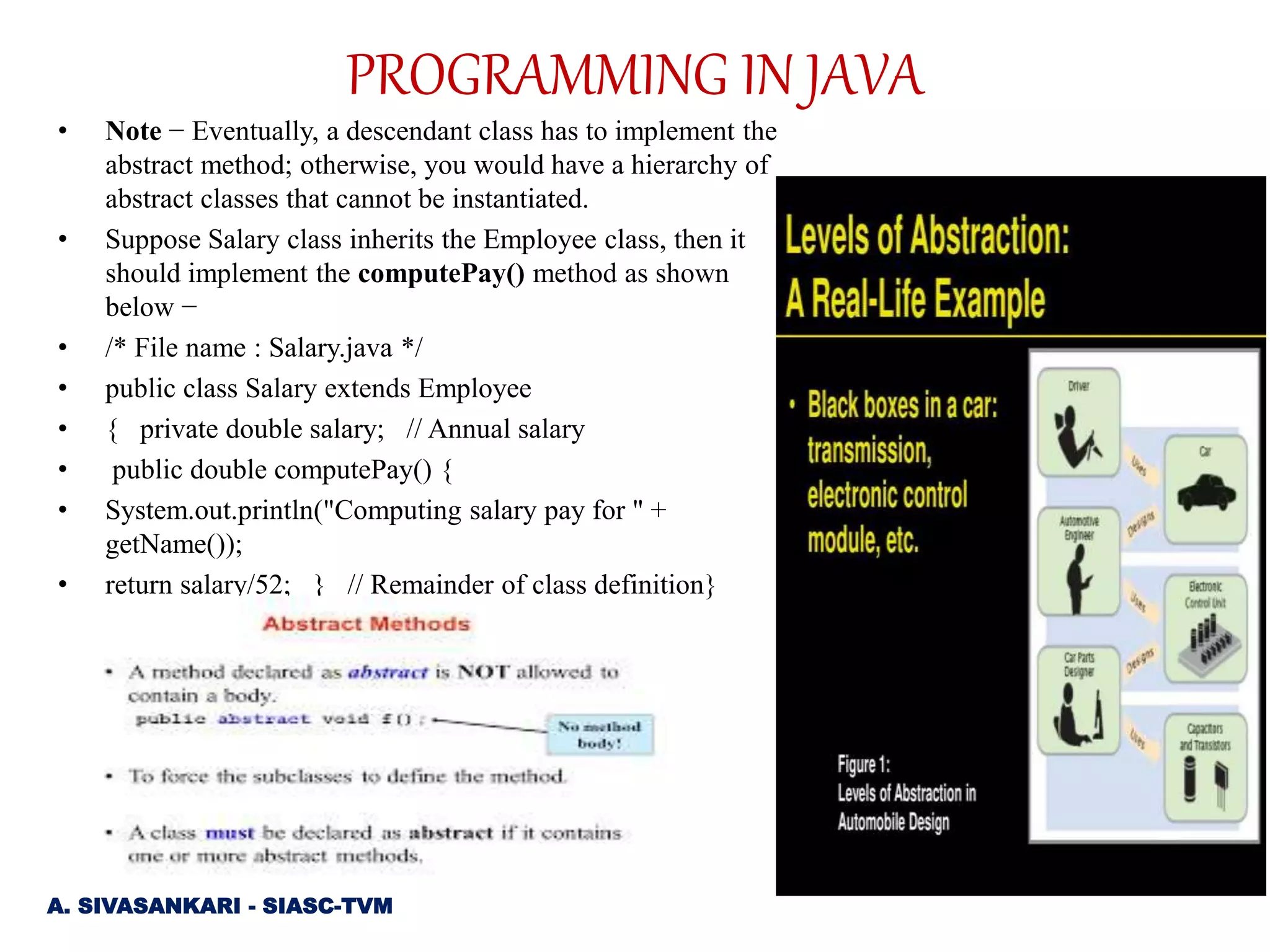
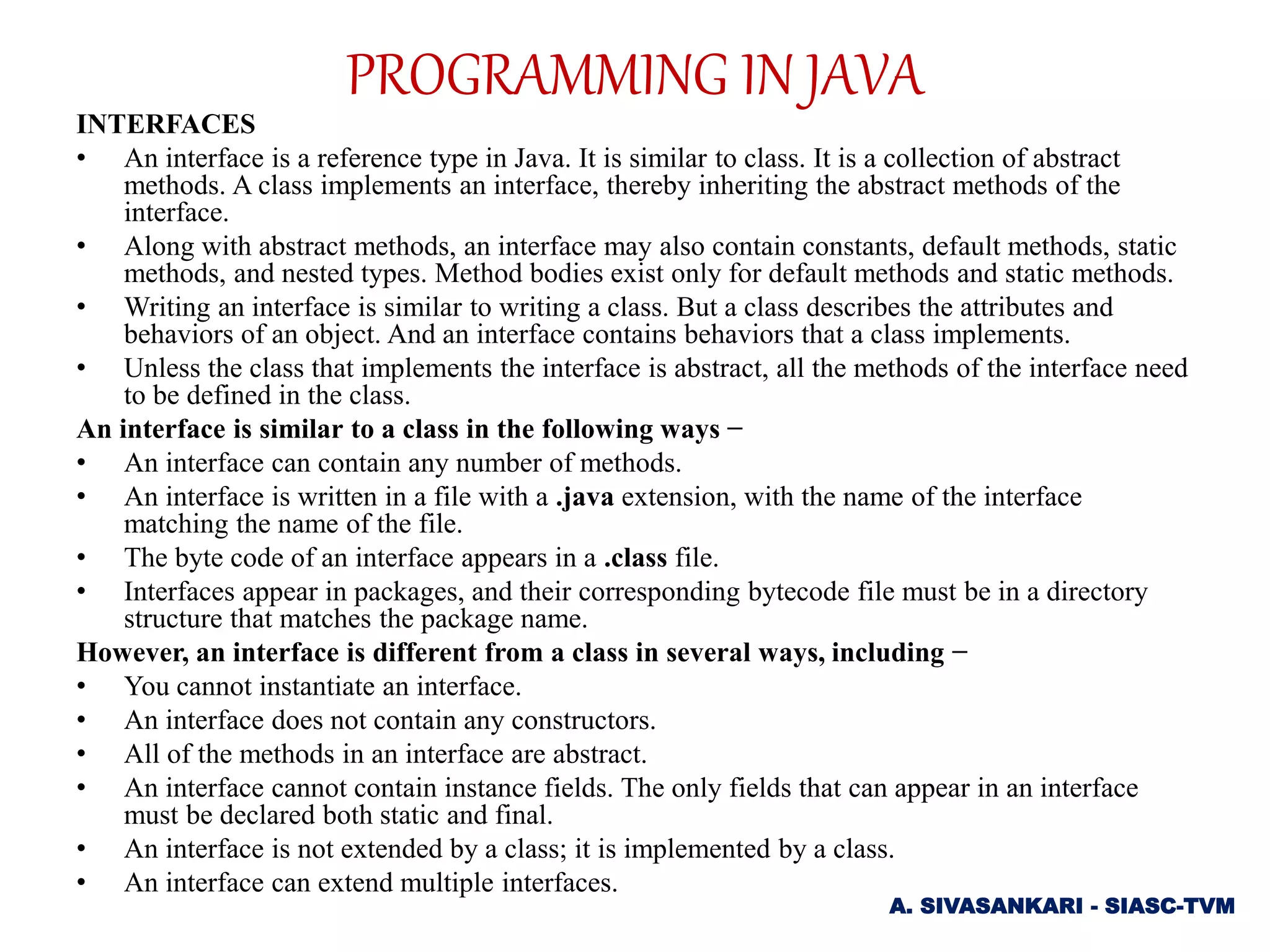
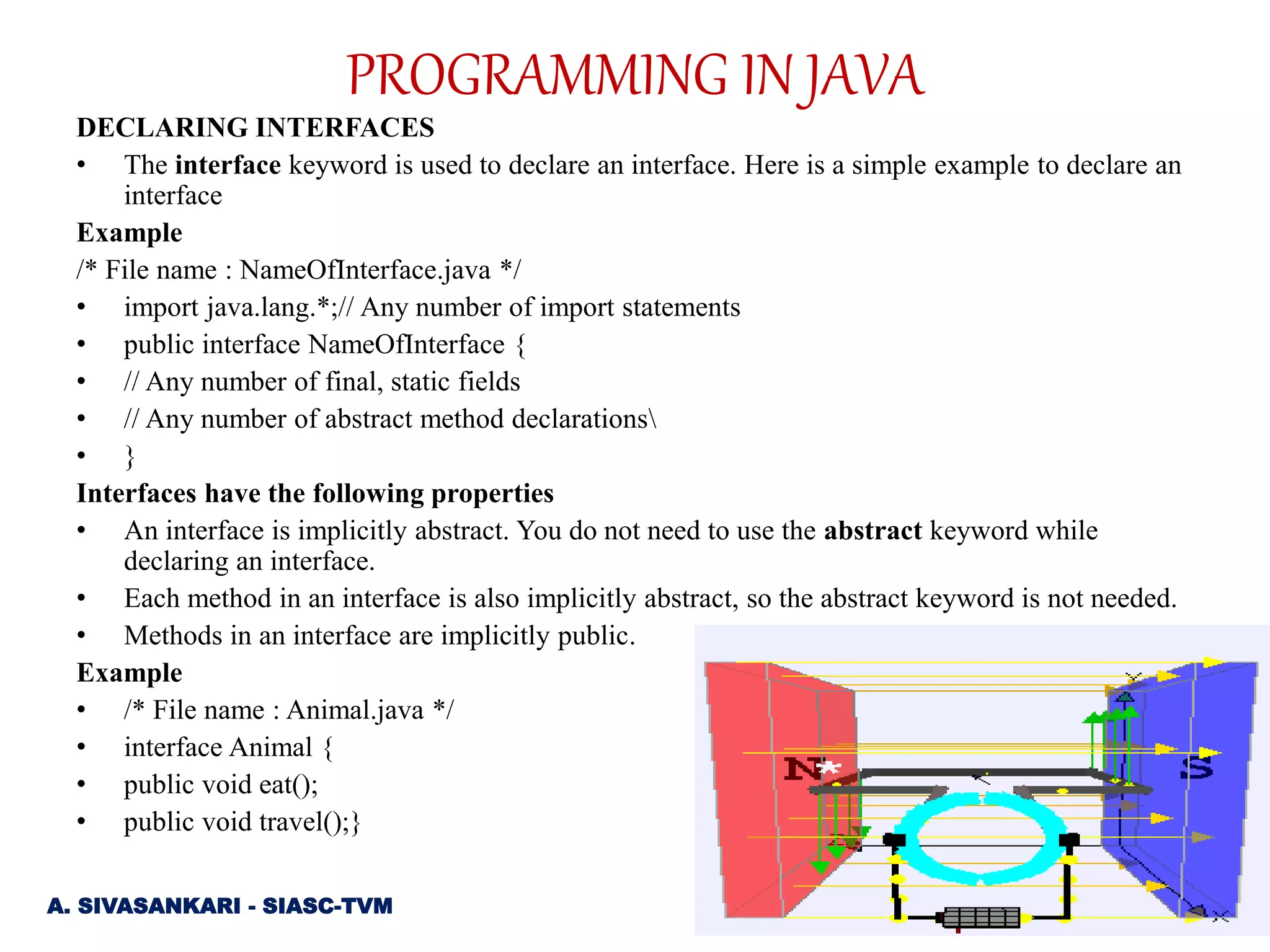
![PROGRAMMING IN JAVA IMPLEMENTING INTERFACES • When a class implements an interface, you can think of the class as signing a contract, agreeing to perform the specific behaviors of the interface. If a class does not perform all the behaviors of the interface, the class must declare itself as abstract. • A class uses the implements keyword to implement an interface. The implements keyword appears in the class declaration following the extends portion of the declaration Example /* File name : MammalInt.java */ • public class MammalInt implements Animal { • public void eat() { • System.out.println("Mammal eats"); } • public void travel() { • System.out.println("Mammal travels"); } • public int noOfLegs() { • return 0; } • public static void main(String args[]) { • MammalInt m = new MammalInt(); • m.eat(); • m.travel(); }} OUTPUT • Mammal eats • Mammal travels A. SIVASANKARI - SIASC-TVM](https://image.slidesharecdn.com/java-unit2-200801165711/75/PROGRAMMING-IN-JAVA-25-2048.jpg)
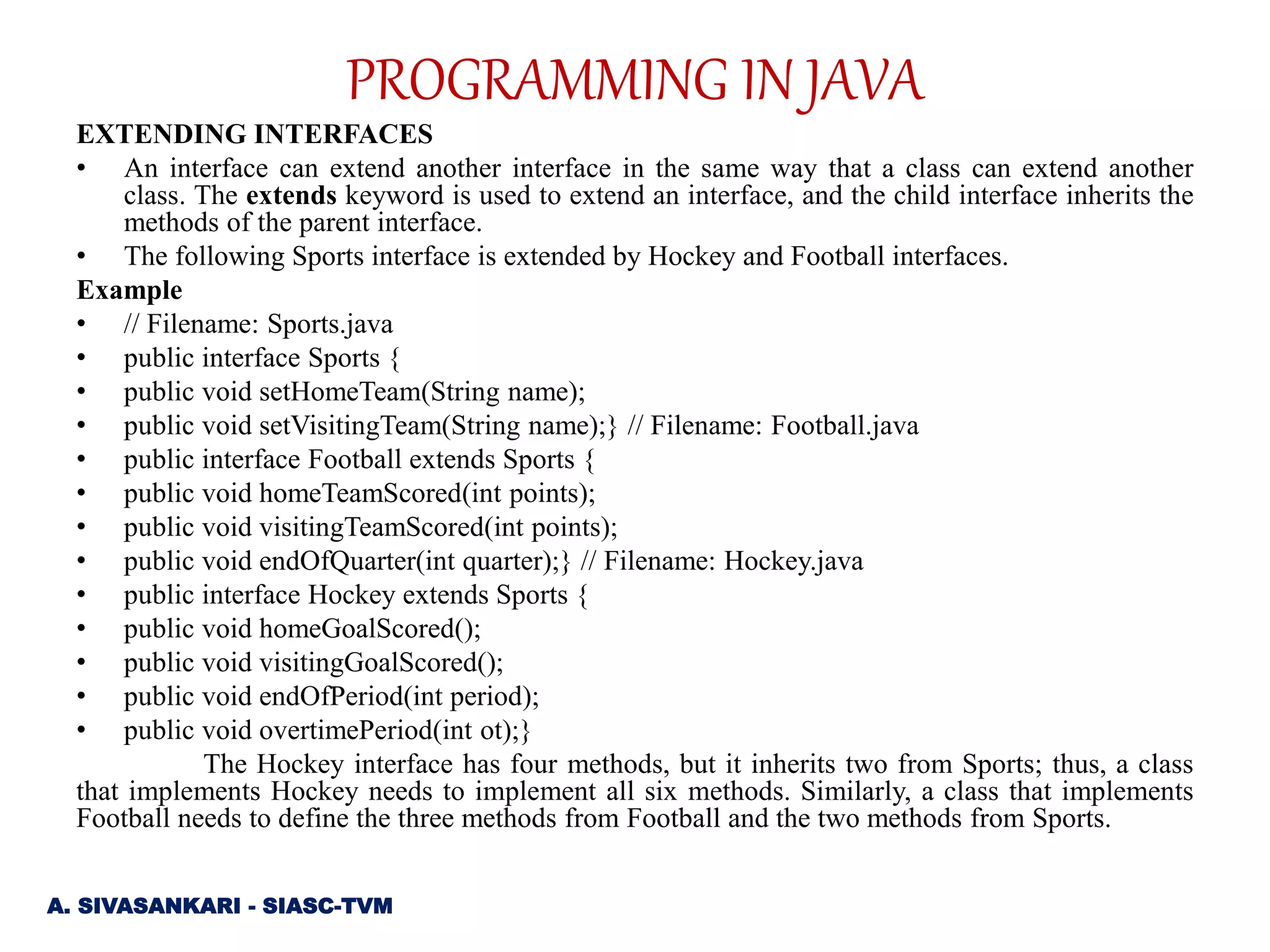
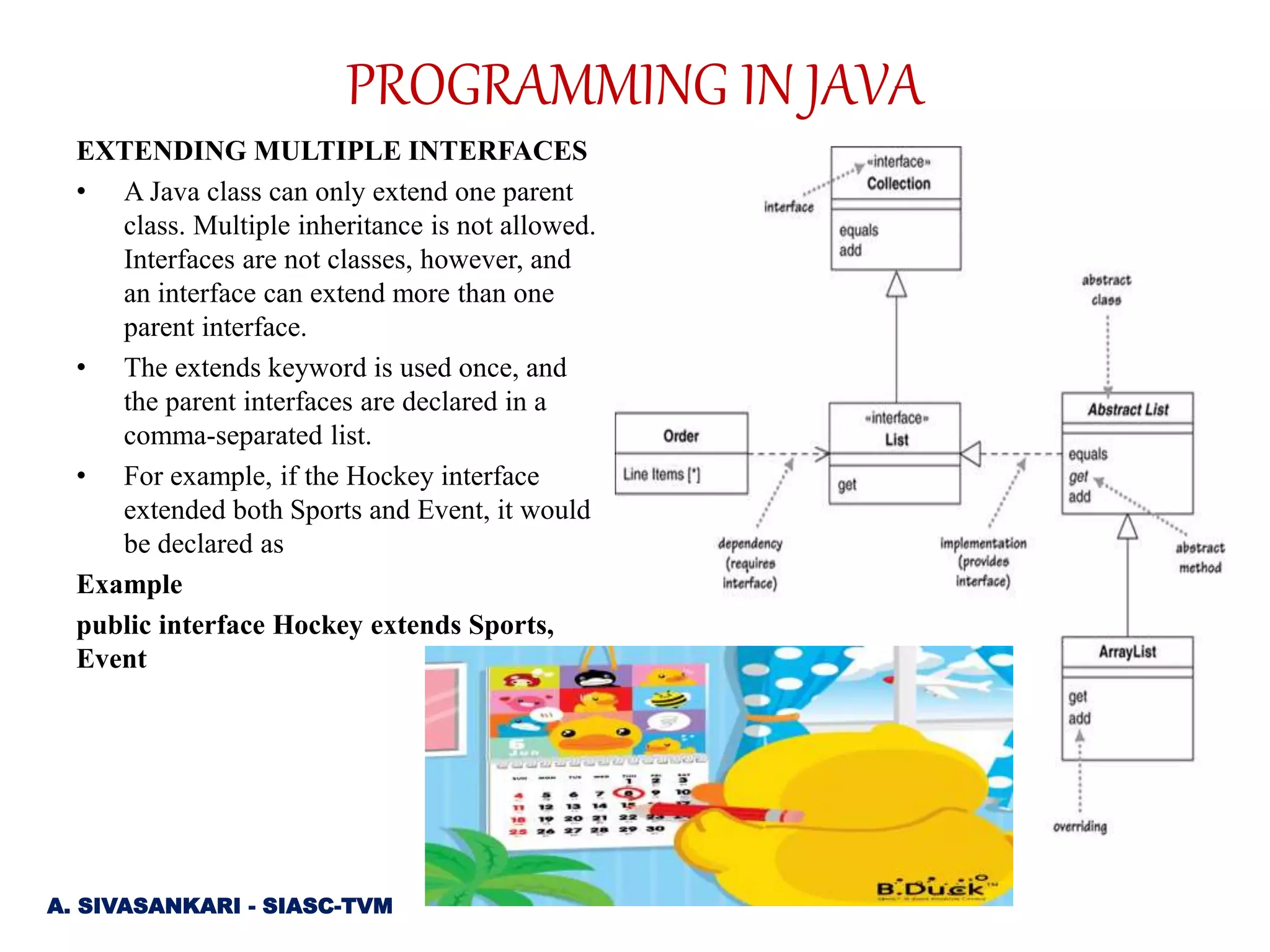
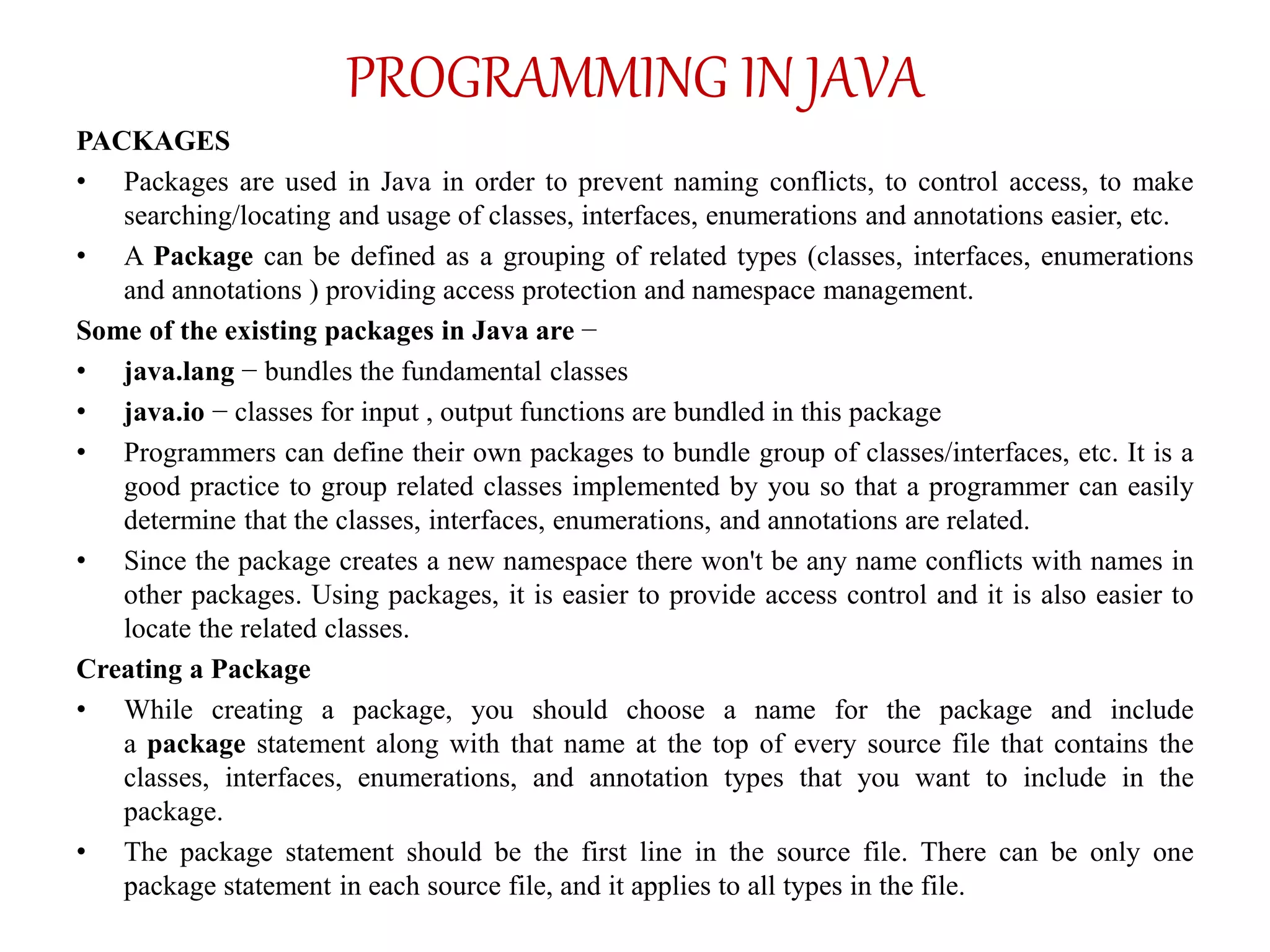
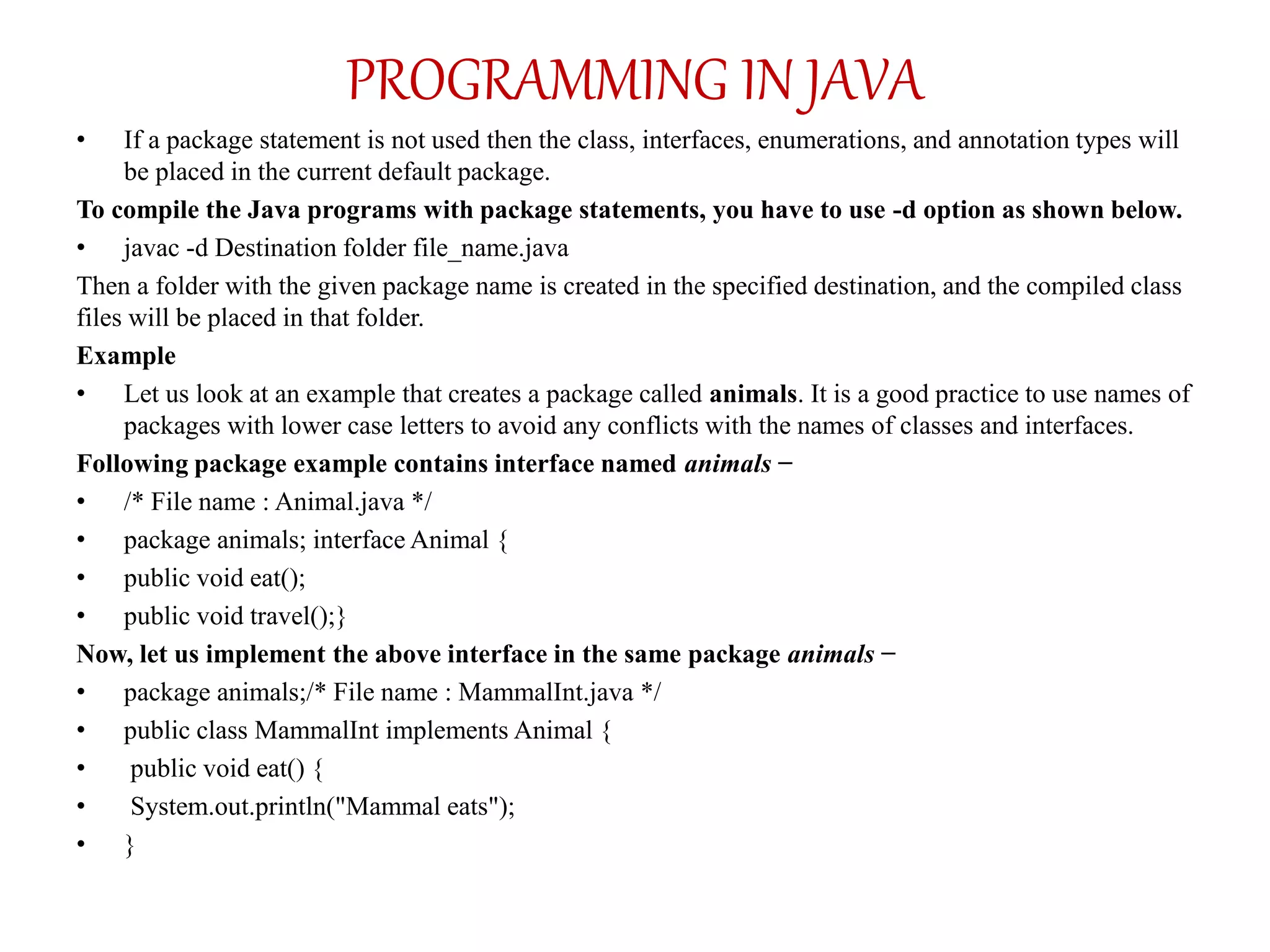
![PROGRAMMING IN JAVA • public void travel() { • System.out.println("Mammal travels"); } • public int noOfLegs() { • return 0; } • public static void main(String args[]) { • MammalInt m = new MammalInt(); • m.eat(); • m.travel(); }} Now compile the java files as shown below − • $ javac -d . Animal.java • $ javac -d . MammalInt.java We can execute the class file within the package and get the result as shown below. • Mammal eats • Mammal travels Now a package/folder with the name animals will be created in the current directory and these class files will be placed in it as shown right](https://image.slidesharecdn.com/java-unit2-200801165711/75/PROGRAMMING-IN-JAVA-30-2048.jpg)
